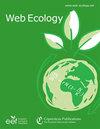土地利用过滤器对三个节肢动物类群种内性状变异影响的证据很少
IF 2.4
3区 环境科学与生态学
Q2 ECOLOGY
引用次数: 0
摘要
摘要在过去的几十年里,物种丰富度和昆虫数量的下降通常是由人为的土地利用造成的,并可能对生态系统功能造成严重后果。许多研究在群落水平上调查了土地利用集约化对物种间表型性状分布的影响,结果往往喜忧参半。然而,生物和非生物的环境过滤器和潜在的选择作用于每个物种内的个体,即在物种的种群水平上,从而驱动种内表型变异的程度。在这里,我们比较了屎壳郎、蜜蜂和蚱蜢的形态性状变异,并将这种变异与森林和草原的土地利用强度联系起来。所选择的性状包括绝对体型和相对腿、翅膀或眼睛的大小或形状,在特定的生态反应或影响背景下通常被解释为“功能性状”。我们预测,与低强度生态系统相比,节肢动物物种个体之间的性状变异性在集约利用的生态系统中(具有明显的环境过滤)有所降低,特别是对于在集约利用地点更丰富的节肢动物物种(“土地利用赢家”与“输家”相比)。总体而言,土地利用强度对性状变异的影响很小,森林的变化随土地利用强度的增加而减小,而草地的变化则增加。尽管许多研究证实了土地利用对物种组成、多样性和性状分布的强烈影响,包括来自相同土地利用梯度的证据,但我们无法证实在种内水平上的一致影响。然而,选择哪些性状包括在分析中,以及表型变异和遗传变异之间的联系可以强烈地影响对生态过程得出的结论。因此,我们建议在未来的研究中,将种内性状变异扩展到其他更具体的反应或效应性状和更广泛的物种上。本文章由计算机程序翻译,如有差异,请以英文原文为准。
Little evidence for land-use filters on intraspecific trait variation in three arthropod groups
Abstract. Declines in species richness and abundance of insects over the last decades
are often driven by anthropogenic land use and can have severe consequences
for ecosystem functioning. Many studies investigated the effects of land-use intensification on the distribution of phenotypic traits across species at the community level, often with mixed results. However, biotic and abiotic environmental filters and potential selection act on individuals within each species, i.e., at the species' population level, and thus drive the extent of intraspecific phenotypic variation. Here, we compare the morphological trait variation within selected species of dung beetles, bees and grasshoppers and link this variation to land-use intensity in forests and grasslands. Selected traits included absolute body size measures and relative leg, wing or eye size, or shape and are often interpreted as “functional traits” in the context of specific ecological responses or effects. We predicted that trait variability among individuals of arthropod species is reduced in intensively
used ecosystems (with pronounced environmental filtering) compared to
low-intensity ones, particularly for arthropod species that were more
abundant in intensively used sites (“land-use winners” compared to
“losers”). In general, only few effects of land-use intensity on trait
variation were found showing a decreasing variation with increasing land-use
intensity in forests but an increasing variation in grasslands. Although
many studies confirmed strong land-use impacts on species composition,
diversity and trait distribution, including evidence from the same land-use
gradients, we were not able to confirm consistent effects at the
intraspecific level. However, the choice of which traits are included in
analyses and the linkage between phenotypic variation and genetic
variability can strongly influence the conclusions drawn on ecological
processes. Therefore, we suggest extending the use of intraspecific trait
variation on other, more specific response or effect traits and a broader
range of species in future studies.
求助全文
通过发布文献求助,成功后即可免费获取论文全文。
去求助
来源期刊

Web Ecology
Agricultural and Biological Sciences-Ecology, Evolution, Behavior and Systematics
CiteScore
4.60
自引率
0.00%
发文量
6
审稿时长
17 weeks
期刊介绍:
Web Ecology (WE) is an open-access journal issued by the European Ecological Federation (EEF) representing the ecological societies within Europe and associated members. Its special value is to serve as a publication forum for national ecological societies that do not maintain their own society journal. Web Ecology publishes papers from all fields of ecology without any geographic restriction. It is a forum to communicate results of experimental, theoretical, and descriptive studies of general interest to an international audience. Original contributions, short communications, and reviews on ecological research on all kinds of organisms and ecosystems are welcome as well as papers that express emerging ideas and concepts with a sound scientific background.
 求助内容:
求助内容: 应助结果提醒方式:
应助结果提醒方式:


